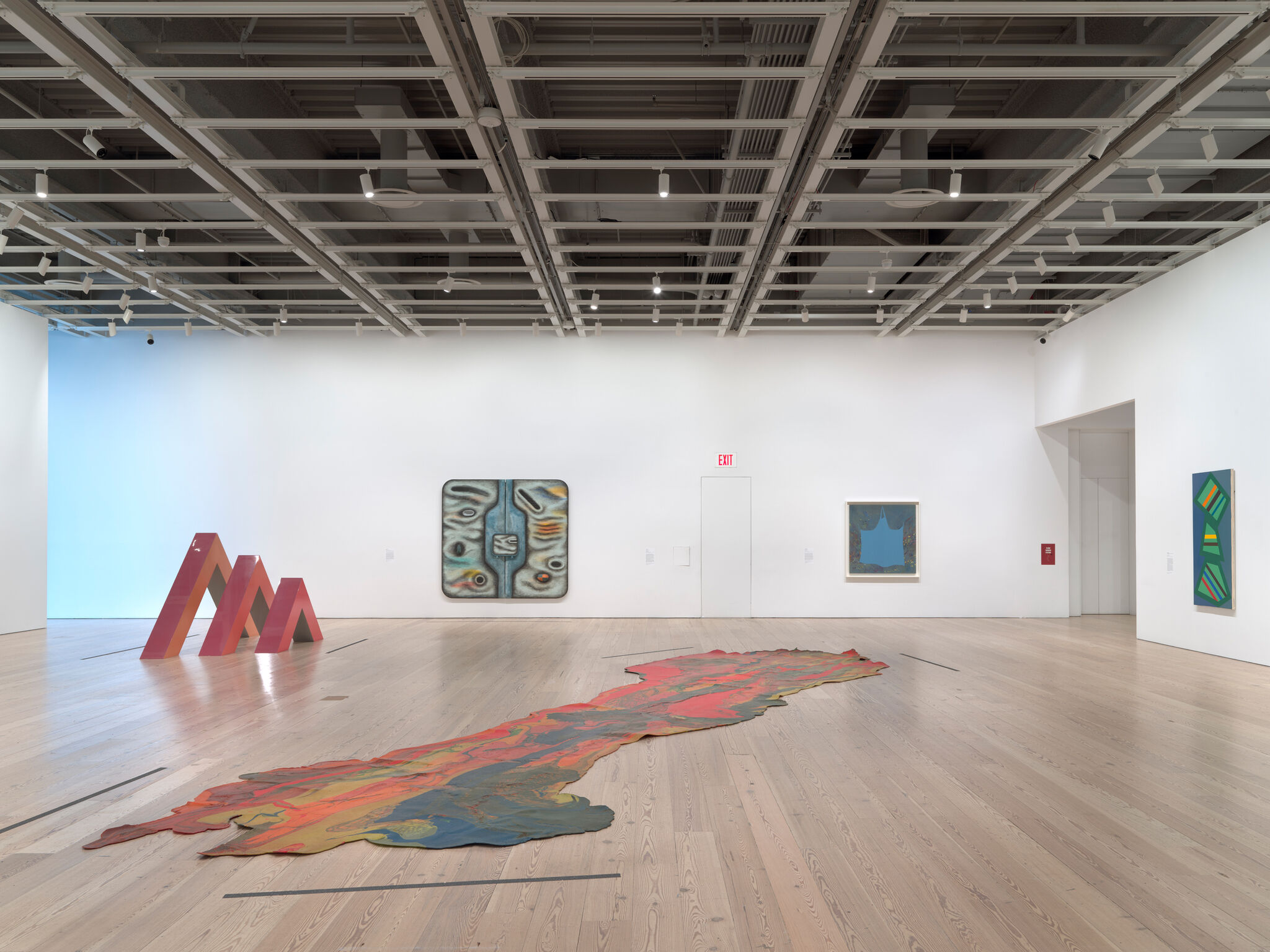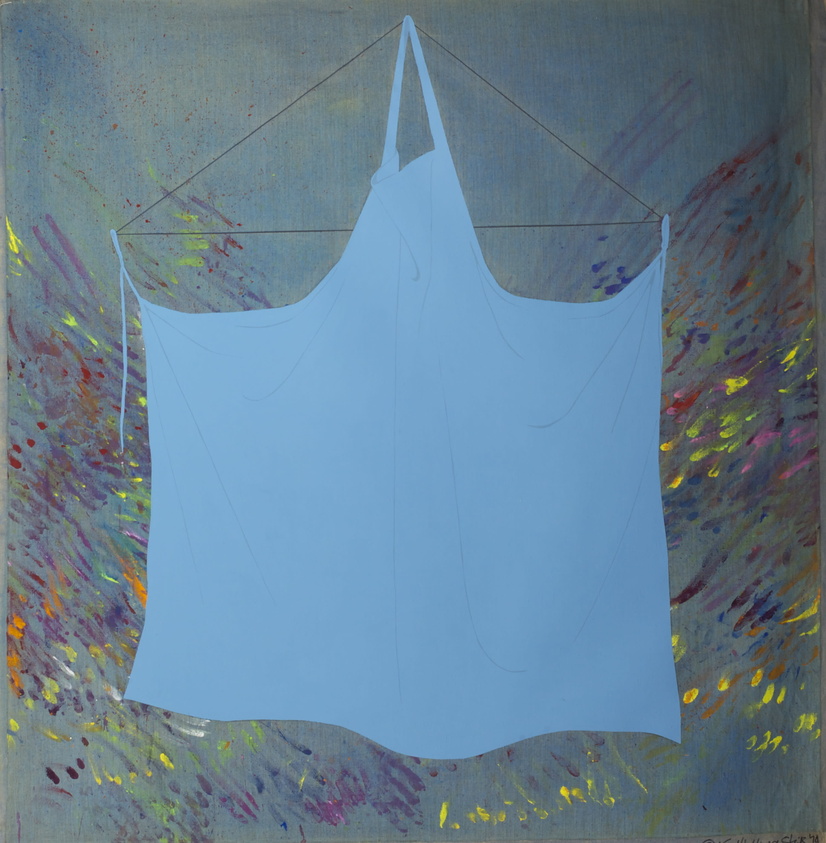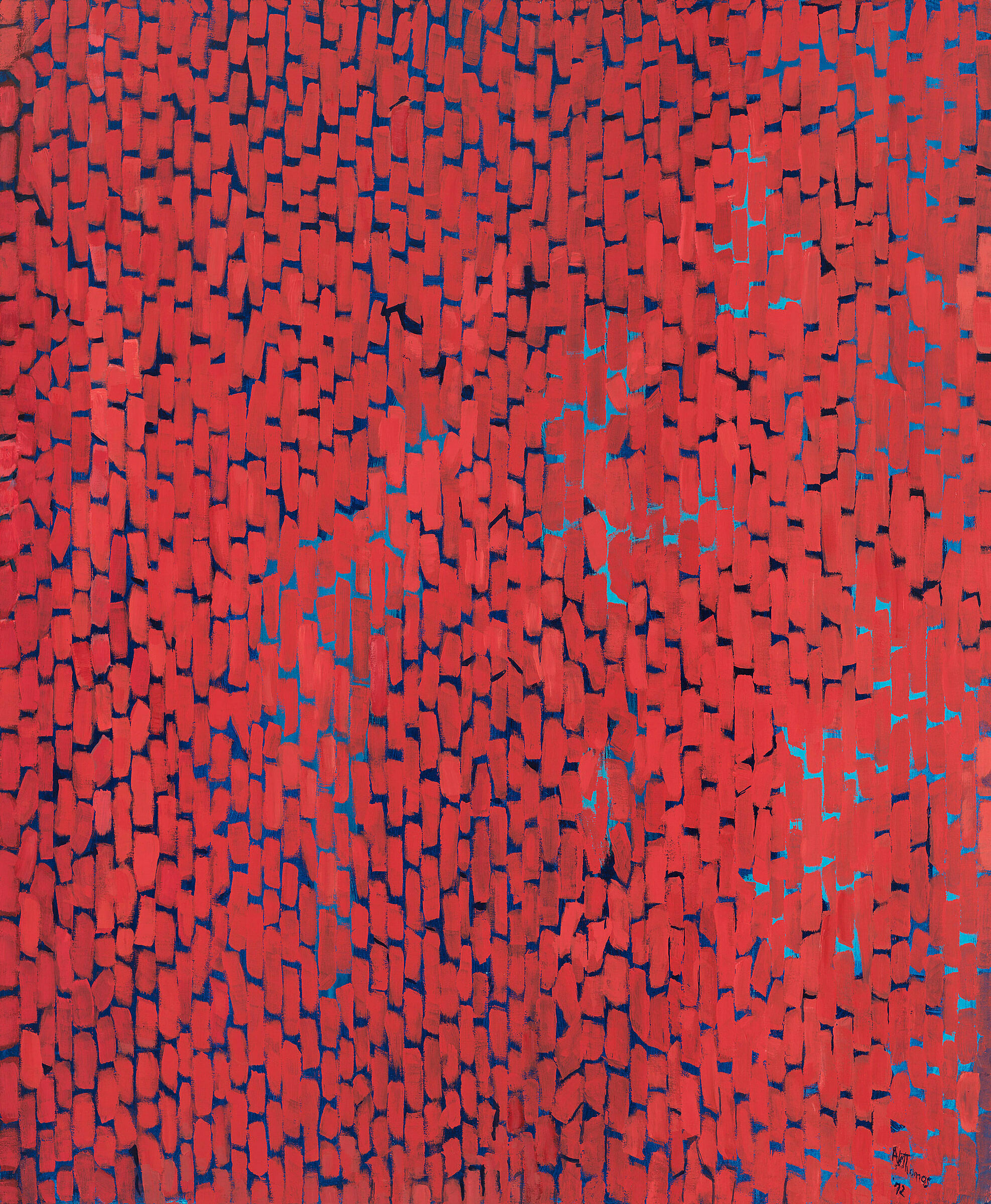Not on view
Date
1974
Classification
Paintings
Medium
Acrylic on canvas
Dimensions
Overall: 52 1/8 × 50in. (132.4 × 127 cm)
Accession number
P.2022.1
Credit line
Whitney Museum of American Art, New York; Promised gift of the Gochman Family and in honor of Forge Project, traditional lands of the Muh-he-con-ne-ok
Rights and reproductions
© artist or artist's estate
Visual description
Kay WalkingStick,Gray Apron, 1974.Gray Apronis an acrylic painting on canvas. The painting measures 52 inches tall by 50 inches wide. The background of the painting, visible around the canvas’s edges, contains short, radial bursts of multicolored marks on a soft gray/blue background almost like hand marks. Squarely in the foreground, a saturated gray apron with a bluish tint hangs, outstretched, from a thinly painted equilateral triangle. The apron’s neck strap hangs from the vertex of the triangle; the back straps of the apron hang from both sides of the triangle’s base. As if in preparation for wear, the apron stretches wide across the canvas. While the apron depicts small, soft folds in its fabric, the garment does not drape on a body, and the garment is relatively flattened.
This painting moves away from simply a representation of an apron, to incorporate the act of artmaking itself. While the apron is represented as an object, white-gray-blue and unstained, the colorful brush strokes and markings moving from behind might connote a messy paint space.
Audio
-
0:00
Kay WalkingStick, Gray Apron, 1974
0:00
Kay WalkingStick: I'm Kay WalkingStick, I'm a painter.
Narrator: This work is part of a series of “apron” paintings that WalkingStick did when she was a graduate student.
Kay WalkingStick: I made a series of paintings about my aprons because, at the time, I was very aware of the fact that I was leading two lives. So this is really a painting about who I am and my life. I was actually making my work aprons out of scraps of canvas linen. I was trying to, through this iconic shape, and I felt it was an iconic shape, that expressed these two connected sides of my life.
In this painting, I was stating who I was as a painter, but also saying, and yes, this painter is a woman who has responsibilities to a family. I'm sure many people on the outside saw me as a suburban housewife who painted. And I was, to me, a painter who happened to be married and had kids.
Narrator: WalkingStick remembers the early seventies as a politically loaded era. Second wave feminism and the American Indian Movement were in full swing. She explains that it was a “very personal” time because women were rethinking their place in society. She was also immersing herself in the New York art world during Minimalism’s rise. The triangle at the top of this work is a nod to the hard-edge forms she saw in her contemporaries’ work, what she described as “diagrammatic paintings.”
Kay WalkingStick: It was to optically support the apron that I put this triangle in.
Looking back on it, I see this triangle a little differently, I see it as balance. And here I am talking about this life of mine, which seems divided and yet actually it was very balanced, like the triangle.
-
Kay WalkingStick, Grey Apron, 1974
In In the Balance: Between Painting and Sculpture, 1965–1985 (Spanish)
0:00
Kay WalkingStick, Grey Apron, 1974
0:00
Kay WalkingStick: Me llamo Kay WalkingStick y soy pintora.
Narrator: Esta obra forma parte de una serie de pinturas de “delantales” que WalkingStick hizo cuando era estudiante de grado.
Kay WalkingStick: Hice una serie de pinturas sobre mis delantales porque, en ese momento, era muy consciente de que llevaba una doble vida. En realidad, esto comenzó como una pintura sobre la mujer que soy y sobre mi vida. Me hacía mis propios delantales de trabajo con retazos de lienzos. A través de esta forma icónica, intenté expresar la conexión entre las dos partes de mi vida.
Con esta obra, estaba afirmando quién era como pintora pero también diciendo “Sí, esta pintora es una mujer que tiene responsabilidades para con una familia”. Seguramente muchas personas ajenas a mi vida me veían como una ama de casa de los suburbios que pinta. Para mí, yo era una pintora que casualmente estaba casada y tenía hijos.
Narrator: WalkingStick recuerda los comienzos de la década de los setenta como una época con una gran carga política. La segunda ola del feminismo y el Movimiento Indígena Americano estaban en la cresta de la ola. Explica que fue un momento “muy personal” para ella, ya que las mujeres estaban volviendo a reflexionar sobre cuál era su lugar en la sociedad. También se estaba sumergiendo en el mundo del arte neoyorquino durante el surgimiento del minimalismo. El triángulo que está en la parte superior de la obra es una alusión a las formas rectas y en punta que veía en las obras de sus colegas contemporáneos, que describía como “pinturas diagramáticas”.
Kay WalkingStick: Quería sostener visualmente el delantal en el que puse este triángulo.
Ahora que vuelvo a verlo, veo este triángulo desde otro punto de vista; lo relaciono con el equilibrio. Y aquí estoy hablando sobre mi vida, que parece dividida pero que, de hecho, está bastante equilibrada, como el triángulo.
-
Verbal Description: Kay WalkingStick, Gray Apron, 1974
In In the Balance: Between Painting and Sculpture, 1965–1985
0:00
Verbal Description: Kay WalkingStick, Gray Apron, 1974
0:00
Narrator: Kay WalkingStick, Gray Apron, 1974. Gray Apron is an acrylic painting on canvas. The painting measures 52 inches tall by 50 inches wide. The background of the painting, visible around the canvas’s edges, contains short, radial bursts of multicolored marks on a soft gray/blue background almost like hand marks. Squarely in the foreground, a saturated gray apron with a bluish tint hangs, outstretched, from a thinly painted equilateral triangle. The apron’s neck strap hangs from the vertex of the triangle; the back straps of the apron hang from both sides of the triangle’s base. As if in preparation for wear, the apron stretches wide across the canvas. While the apron depicts small, soft folds in its fabric, the garment does not drape on a body, and the garment is relatively flattened.
This painting moves away from simply a representation of an apron, to incorporate the act of artmaking itself. While the apron is represented as an object, white-gray-blue and unstained, the colorful brush strokes and markings moving from behind might connote a messy paint space.
Installation photography
-


Installation view of In the Balance: Painting and Sculpture, 1965-1985 (Whitney Museum of American Art, New York, October 19, 2022 – March 5, 2023). From left to right: Lynda Benglis, Contraband, 1969; Judy Chicago, Trinity (Outdoor Version), 1965/2019; Tishan Hsu, Outer Banks of Memory, 1984; Kay WalkingStick, Gray Apron, 1974; Freddy Rodriguez, Y me quedé sin nombre, 1974. Photograph by Ron Amstutz
From the exhibition In the Balance: Between Painting and Sculpture, 1965–1985


